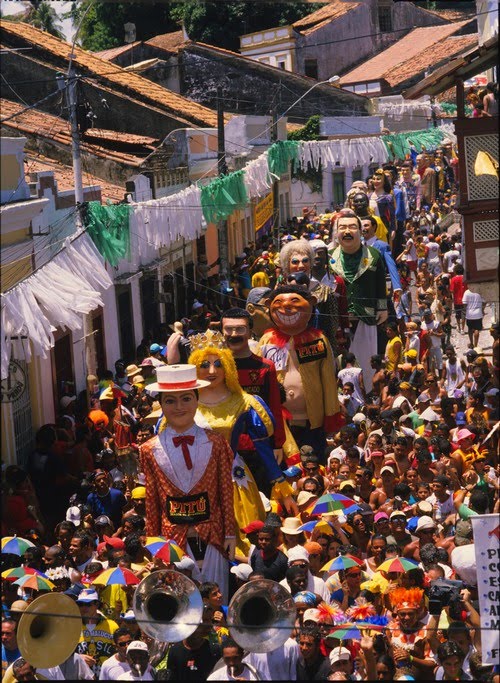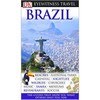Olinda - Pernambuco - Brazilian Cities
They say that the name “Olinda” originates from the words of a Portuguese Nobleman, Duarte Coelho, Pernambuco’s High Commissioner, when he searched for a place to establish a settlement. Upon finding a hill with a magnificent sea view and a natural harbor protected by reefs, he said: “ Oh, beautiful place to build a village”. (“Oh, beautiful”, translated from the Portuguese: “Oh, linda”, thus the name “Olinda”. Truth or legend, what matters is that the city is really quite beautiful. From its foundation on, the village prospered in trade and became wealthy. However, the Dutch invaded it in 1630. After setting the city on fire, they abandoned it and moved to Recife, then just a seaport. Only after the invaders were driven out in 1654 did the village’s reconstruction begin. Much was preserved from that time: part of the original urban layout, old baroque churches and houses. Together, they comprise an important architectural collection, making Olinda part of Humanity’s Cultural Heritage. They also set the scenario of one of the most original carnivals of the country in street games, music and dance. It is quite rewarding to go out on the streets of the city and admire the landscape blending with the sea blue, vegetation green and the beauty of historical buildings. It is a pleasurable place also for lovers of good restaurants, authentic craftwork and art studios.
Events
Street carnival
During the Carnival, one of the most vivacious feasts in the country takes place. Olinda citizens and tourists perambulate the narrow slanting streets dancing to the music of “frevo” and “maracatu” bands. The traditional mockery blocks and the famous giant dolls participate throughout the fun. On these days, Olinda becomes a vast stage for popular cultural manifestation.
Holy Week
It represents the end of lent, a forty-day period after carnival. Beautiful processions take place throughout the city.
Iemanjá Feast (December)
Female Orixa (Goddess) that personifies the sea. She is the mother of all Orixás, the Mistress of the Earth and Heavens. The Blue Walk, as the procession is called, is a cortege that conducts the figure of Iemanjá on an allegoric vehicle accompanied by the “Holy sons” and a large crowd leading the “Pot of Offerings”, which is deposited into the sea.
Christmas (December)
Our Lord of Bonfim Church (1758) and the Palace of Governors, where the “Palace Christmas” takes place with a Christmas presentation, pastoral events, folkloric dances and choirs, are the top visiting places of the Christmas festivities.
Christmas Serenade (December)
A group of singers and musicians accompanied by a large crowd walk through the streets of the High City playing Christmas carols and praises to Olinda. The serenade begins at the Sé Cathedral with a large number of guest choirs led by Olinda’s Martyr Saint Peter Choir.
Revolinda (December)
New Year’s celebration on the beaches, mostly concentrated on the Bairro Novo and Casa Caiada beaches. Great fireworks and much animation to celebrate the New Year.
Attractions
Churches
Olinda holds churches rich in ornaments and carvings, as well as simple churches. Majority were built in the 16th and 17th centuries and display baroque (16th-17th Century European style) architecture and statues. Some deserve highlight such as the São bento Monastery with a gold plated altar, and the São Francisco Convent, which integrates a group of temples. The Sé Cathedral, on a location of privileged view, is the oldest of the city and one of the first to be built in Brazil.
Art Studios
Plastic artists have setup their studios throughout the city. Visitors are welcome. They are free to enter and admire the paintings, sculptures and ceramic works.
Sacra Art Museum
The building holds the rich religious art of Pernambuco State. Built before the arrival of the first bishop in 1976, it was rebuilt in the 19th century. The Palace also has two antiquate blocks, and twelve windows on the upper floor, built later on, with wooden balconies in 18th century style. The permanent collection was given by the Archdiocese of Olinda and Recife, and later on refined. Today, it gathers religious pieces of the 16th century, including important specimens of the contemporaneous popular art. The museum currently develops an active program with courses, lectures and exhibitions that accompany the liturgical period and religious calendar. On the ground floor, an exhibition of photographic panels documenting the history, evolution and landscape of Olinda.
Bairro Novo Beach
With a 2.7 km extension, the beautiful and bustling beach of Bairro Novo is the most visited by tourists and with the best structure. Olinda has only 11 km of coastal area distributed into seven beaches, some of which are inaccessible for sea bathing due to the topography of the area yet highly attractive for contemplative leisure.
Rua do Amparo
This street is the cultural pole of the city’s historical sector with restaurants, inns, museums and art studios.
Shopping
Ribeira Market
It is a building from the late 17th century with shops where one can buy local craftwork such as the typical “machê” paper (paper-pulp) masks. It holds sculpting, engraving and painting workshops as well. Rua Bernardo Vieira de Melo (Ribeira). 09 am/ 6 pm.![]() More on Brazil:
More on Brazil:![]() Brazilian Ethnic Tourism
Brazilian Ethnic Tourism![]() Brazilian Popular Parties
Brazilian Popular Parties![]() Brazilian Ecotourism - Cross-Walks
Brazilian Ecotourism - Cross-Walks![]() Brazilian Churrasco Barbeque
Brazilian Churrasco Barbeque![]() Excellent hotel options are always available
Excellent hotel options are always available![]() Fun is included in every daily rate
Fun is included in every daily rate![]() Rio de Janeiro
Rio de Janeiro
January 1, 2008
Olinda - Pernambuco
0
comments
0
comments
|
|

 Welcome to Travel to Brazil.
Welcome to Travel to Brazil.
